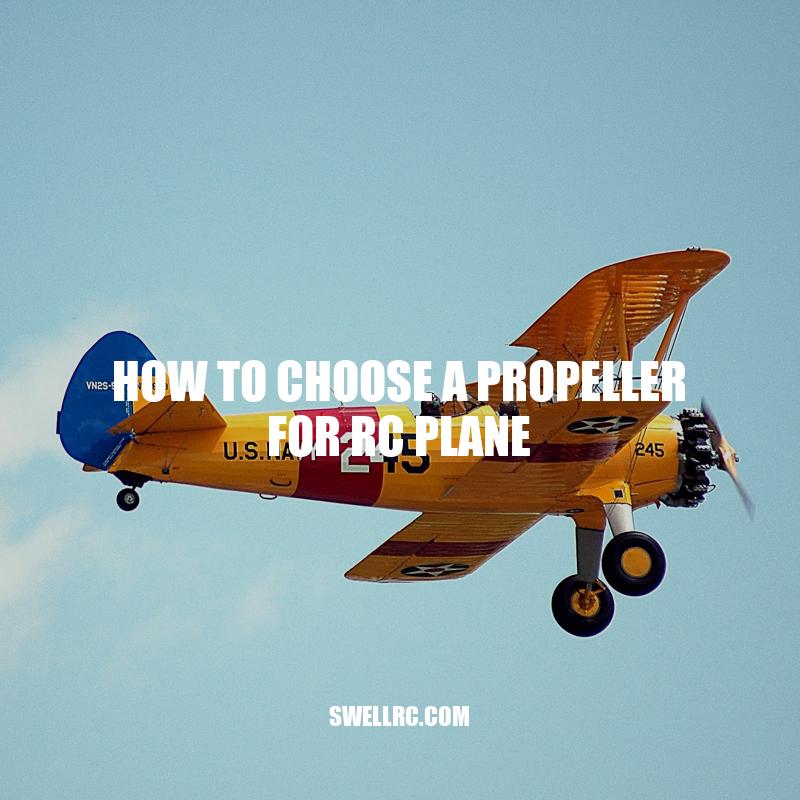Choosing the Right Propeller for Your RC Plane: A Guide
When it comes to remote control (RC) planes, choosing the right propeller is crucial for optimal performance. The propeller affects everything from the speed and stability of your plane to its flight time and maneuverability. With so many different types of propellers available, it can be overwhelming to choose the right one. This article will guide you through the key factors to consider when selecting a propeller for your RC plane. By the end, you’ll have a better understanding of what to look for and be able to choose a propeller that enhances your flying experience.
Understanding Propeller Size
The size of your propeller is one of the most important factors to consider when choosing a propeller for your RC plane. Here are some things to keep in mind when selecting the size:
- Propeller size is determined by its length and pitch.
- A larger propeller will produce more thrust, but may also drain the battery more quickly.
- A smaller propeller will produce less thrust, but can help conserve battery life and increase flight time.
- Choosing the right size propeller will depend on the type of RC plane you have and your flying goals.
One of the best ways to determine the correct propeller size for your RC plane is to reference the manufacturer’s recommendations. You can find this information in your plane’s instruction manual or on the manufacturer’s website. Another helpful resource is to search online forums where RC enthusiasts share their experiences and recommendations for different propellers.
How do you size an RC plane prop?
When it comes to selecting the right propeller for your RC airplane, size matters. Here are the basic steps to follow:
- Determine the maximum rpm of your engine.
- Refer to the manufacturer’s chart to match the recommended propeller size and pitch with your engine rpm.
- Make sure the propeller has the right diameter and pitch size for your aircraft’s weight, and desired speed and thrust.
- Consider the material of the prop, which can affect its efficiency, durability and noise level.
For more in-depth information and propeller sizing tools, check out websites like APC Propellers or Master Airscrew.
Understanding Propeller Pitch
Another important factor to consider when selecting a propeller for your RC plane is the pitch. The pitch of a propeller refers to the distance that the propeller would travel in one full rotation if it were moving through a solid (i.e., no slippage). Here are some things to keep in mind when selecting the pitch:
- Higher pitch propellers make the plane go faster but may draw more current from your battery, causing shorter flight times.
- Lower pitch propellers produce less speed, but are more efficient and use less energy from the battery.
- A pitch range of 4-6 inches is typical for most RC planes.
- For planes with larger or stronger motors, higher pitch propellers can be used, while planes with smaller motors generally do better with lower pitch propellers.
Pitch is usually expressed as a numerical value called the pitch angle, and is measured in inches. For example, a propeller with a pitch of 6 inches would move 6 inches forward in the air with each rotation. The table below shows some examples of recommended propeller sizes and pitches for different types of RC planes:
| Plane Type | Propeller Size | Propeller Pitch |
|---|---|---|
| Trainer planes | 10-12 inches | 5-7 inches |
| 3D planes | 8-10 inches | 3-5 inches |
| Electric ducted fan jets | 3-4 inches | 2-3 inches |
When purchasing propellers, it’s important to select the appropriate size and pitch for your RC plane. There are many brands and types of propellers on the market, such as those from APC and Graupner. It’s also a good idea to read reviews and get recommendations from other RC plane enthusiasts before making a purchase.
What is pitch of RC plane propeller?
The pitch of an RC plane propeller refers to the distance the propeller would move forward if it rotated one full turn. This distance is measured in inches, and it is represented as a number. A higher pitch number means that the propeller will travel a longer distance with each rotation. Some websites, such as Horizon Hobby, offer a variety of RC plane propellers with different pitches to accommodate different types of planes and flying styles.
Material of the Propeller
Propellers for RC planes are made from a variety of materials, including plastic, carbon fiber, and wood. Here are some things to keep in mind when selecting the material for your propeller:
- Plastic propellers are the most affordable and widely available option. They are also lightweight and come in many different sizes and pitches.
- Carbon fiber propellers are more expensive than plastic, but they are stronger and more durable. They are also lighter, which can improve performance.
- Wooden propellers are heavier than plastic or carbon fiber and can be more expensive. However, they are quiet and can produce a classic, old-school look for vintage planes.
- Some websites allow you to customize your propeller by selecting the material, pitch, and blade shape. These sites can be a great option for experienced pilots who want a unique and high-performing propeller.
Ultimately, the choice of material will depend on personal preference, budget, and the specific needs of your RC plane. For most beginners, plastic propellers are a good option, while more experienced pilots may want to invest in carbon fiber or wood for improved performance or aesthetics. It’s important to choose a high-quality propeller from a reputable brand to ensure a safe and enjoyable flying experience.
What is the best material for aircraft propellers?
The best material for aircraft propellers is a crucial question for aviation enthusiasts. Here are some materials commonly used and their advantages:
- Aluminum: Lightweight and durable, this is the most common material used for propellers.
- Composite: Made of carbon fibers or other materials, these propellers are stronger and lighter than aluminum. However, they are more expensive.
- Wood: Used in vintage and experimental aircraft, wood propellers offer a classic aesthetic and good performance. However, they require regular maintenance.
Ultimately, the material used for an aircraft propeller will depend on factors such as budget, performance needs, and aesthetic preferences.
Brand Reputation
When it comes to selecting a propeller for your RC plane, choosing a reputable brand can make a big difference. Here are some things to keep in mind when looking for a reliable brand:
- Go with established brands that have been making RC plane propellers for a long time
- Research brands by reading reviews, forums, and recommendations from other RC enthusiasts
- Look for brands that offer warranties or customer support, as this can help you troubleshoot issues and get replacement parts
- Some popular brands for RC plane propellers include APC, Master Airscrew, and XOAR
- Online marketplaces like Amazon and eBay can be good places to find propellers from many different brands, but it’s important to read reviews carefully and only buy from reputable sellers
While it’s tempting to buy the cheapest propeller available, investing in a high-quality propeller from a trusted brand can save you money and frustration in the long run. Not only will it perform better, but it will also last longer and be safer to use.
Which is better 3 blade or 2 blade propeller RC?
Here is some information to help you understand the differences between 3 blade and 2 blade propellers in RC planes:
- A 3 blade propeller produces more thrust, but less speed compared to a 2 blade propeller.
- 3 blade propellers are recommended for heavier planes or planes with higher wing loading
- 2 blade propellers are better for faster flying planes or planes with lower wing loading
- The type of propeller also depends on personal preference and flying style.
Before choosing the type of propeller, consider your plane’s weight, wing loading, and recommended propeller size. Additionally, websites such as HobbyKing and Tower Hobbies offer a wide range of propellers for RC planes, both 3 blade and 2 blade, for you to choose from.
Conclusion
Choosing the right propeller for your RC plane can be a daunting task, but by considering factors like size, pitch, and material, as well as researching reputable brands, you can find a propeller that will give you the performance and flight characteristics you desire. Whether you’re a beginner or an experienced pilot, understanding propellers and how they work is essential to getting the most out of your RC plane.
Remember that finding the perfect propeller may take some trial and error. Don’t be afraid to experiment with different sizes, pitches, and brands until you find the right combination. In the end, the propeller that works best for you will depend on your specific needs and preferences.
Investing in a high-quality propeller is a smart choice for any RC pilot. Not only will it improve your plane’s performance and reliability, but it will also make your flying experience more enjoyable. So take the time to research and choose the right propeller for your RC plane, and get ready to take to the skies with confidence!



